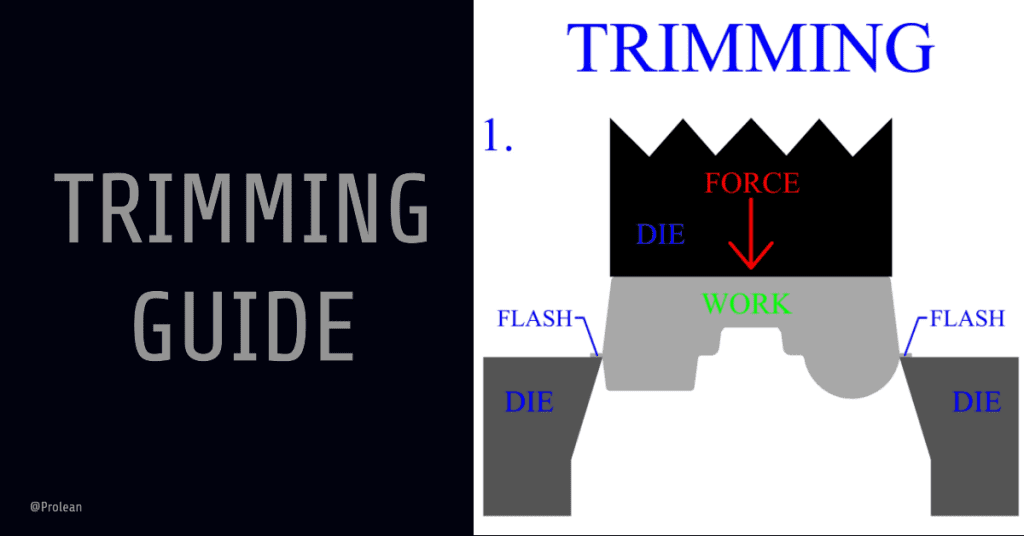
In the world of sheet metal manufacturing, precision, and quality are paramount. Among the various processes that contribute to these factors, trimming holds a significant place. Trimming, essentially a shearing process involves cutting off excess material from the sheet metal part after it has been formed. This critical operation ensures that the part fits perfectly into the final assembly, adhering to the stringent specifications and tolerances of the manufacturing industry.
In this comprehensive guide, we’ll delve deep into the trimmng process, breaking down each step for a thorough understanding.
Understanding the Basics of Trimming
In the realm of sheet metal manufacturing, trimming is a shearing process that removes excess material from a formed part. It is a crucial step that helps to achieve the desired size, shape, and finish, ensuring the manufactured parts conform to strict industry standards. The primary purpose of the trimming process is to cut away any surplus material from the sheet metal part. This allows the manufacturer to achieve the correct dimensions and the precise shape for the final product.
How Does the Trimming Work?
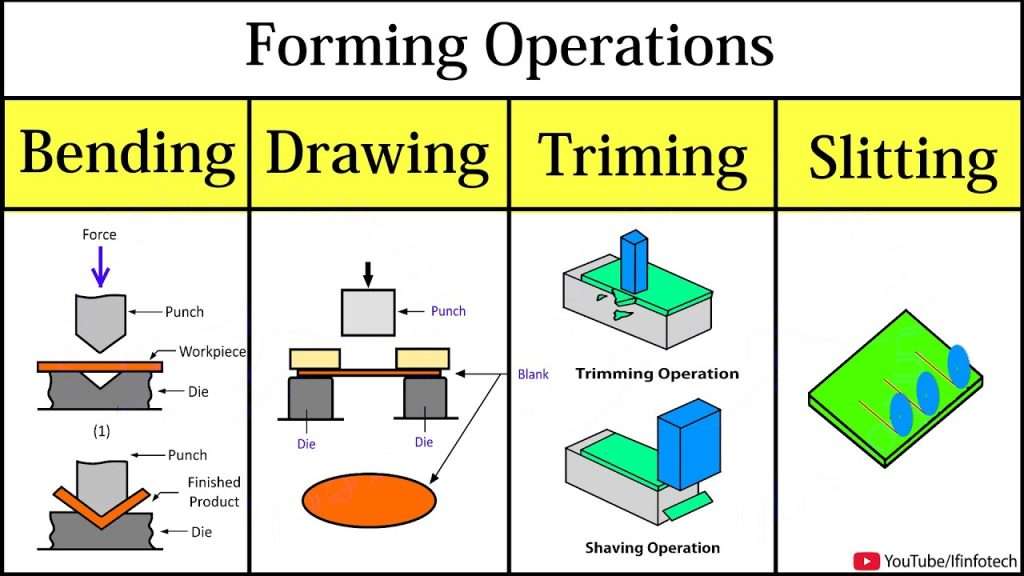
Trimming operates on the basic principle of shearing. A trimming die, which contains the desired shape of the product, is used to cut the excess material. The sheet metal part is placed in the die, and a press applies force, causing the die to cut away the unwanted portions.
Key Equipment The primary machinery involved in the trimming process is the trimming die and the press machine. The die is the tool that cuts the metal, while the press provides the necessary force to facilitate the operation.
- Trimming Die
- Press Machine
Related to: The Importance of Trimming Operations in Sheet Metal Manufacturing
Steps Involved In the Trimming Process
The trimming process involves several steps that must be executed with precision to ensure the final product meets the exacting standards of the manufacturing industry. Let’s take a closer look at the steps involved in the trimming process.
Step 1: Material Selection
Material selection is a critical step in the trimming process. The material’s properties, such as its hardness, ductility, and thickness, can significantly impact the success of the operation.
Factors to Consider When selecting the material for the trimming process, there are several key factors to consider.
- Hardness: Harder materials require more force to cut but may result in a cleaner trim.
- Ductility: More ductile materials can deform more before breaking, affecting the trim’s smoothness.
- Thickness: The thickness of the material determines the level of force required for the operation and the type of die to be used.
Step 2: Trimming Die Design and Creation
The trimming die plays a pivotal role in the trimming process. A well-designed and well-made die can ensure the precision and efficiency of the operation.
| Sub-steps | Description | Objectives |
|---|---|---|
| Designing the Die | Creating a 2D design using CAD software, which is then converted into a 3D model. The design should also consider the type of material being used and the force applied during the trimming process. | Accurately represent the final product’s shape and size. |
| Creating the Die | Creating the die using techniques like milling or wire EDM (Electrical Discharge Machining). The die must be made from a material that is harder than sheet metal to withstand the force of the trimming process. After manufacturing, the die is carefully inspected to ensure it matches the design specifications. | Ensure the die is made from a material that can withstand the force of the trimming process. |
Step 3: Setting Up the Trimming Operation
Once the material is selected and the die is created, the next step is setting up the trimming operation. This step involves preparing the machinery and adjusting the parameters to ensure an effective and efficient trimming process.
| Sub-steps | Description | Objectives |
|---|---|---|
| Preparing the Machinery | Cleaning and inspecting the trimming die and the press machine. Ensuring that the die is correctly mounted on the press. | Ensure the machinery is in good working order and the die is free of any dust or debris. |
| Adjusting the Parameters | Setting the pressing force according to the material’s hardness and thickness. Setting the feed rate and ensuring the material is aligned correctly with the die. | Achieve optimal trimming results by adjusting the pressing force, feed rate, and material alignment. |
Step 4: Executing the Trimming Process
With the machinery set up and the parameters adjusted, the trimming process can now be executed. This step involves feeding the material into the press, executing the trim, and inspecting the trimmed part.
| Sub-steps | Description | Objectives |
|---|---|---|
| Feeding the Material | The material is placed into the press machine and aligned with the trimming die. The material should be positioned so that the areas to be trimmed are accurately aligned with the die. | Ensure the material is properly positioned for the trimming process. |
| Executing the Trim | Once the material is properly positioned, the press is activated to force the die onto the material, trimming off the excess parts. This process may be performed multiple times, depending on the design of the part. | Remove excess material and create the desired shape and size of the finished product. |
| Inspecting the Trimmed Part | After the trimming operation, the part is inspected to ensure that it meets the design specifications. Any imperfections or inconsistencies can indicate issues with the trimming process that need to be addressed. | Confirm that the finished product meets the required quality standards. |
Step 5: Post-Trimming Activities
After the trimming process, there are a few additional activities to ensure the quality of the finished product and the ongoing effectiveness of the trimming operation.
| Sub-steps | Description | Objectives |
|---|---|---|
| Finishing | Additional finishing processes like deburring or grinding may be required to smooth out rough edges or remove residual material from the trimming process. | Ensure the final product has a smooth finish. |
| Cleaning and Maintenance | It’s important to clean the machinery and perform regular maintenance to keep it in good working order. This includes cleaning the die to remove any residual material and inspecting the machinery for any signs of wear or damage. | Prolong the lifespan of the machinery and prevent unexpected downtime. |
| Record Keeping | Keeping detailed records of each trimming operation can help track performance over time and identify any potential issues or areas for improvement. This can include data on the material used, the settings of the machinery, the number of parts trimmed, and the results of the inspections. | Track the performance of the trimming operation and identify any areas for improvement. |
Tips for Successful Trimming Operations
For efficient and quality trimming operations in sheet metal, there are several best practices that manufacturers can follow.
- Regular Maintenance of Equipment Regular maintenance is crucial to the overall success of the trimming process. The trimming machine and dies should be cleaned and inspected regularly to ensure they are in optimal working condition. Regular maintenance also helps to prolong the lifespan of the equipment and prevent any unexpected downtime.
- Quality Material Selection The selection of quality materials plays a vital role in the trimming process. Higher quality materials are often easier to trim and result in cleaner, more precise cuts. Furthermore, they are less likely to produce burrs or imperfections in the finished product.
- Proper Training Proper training for the operators of the trimming equipment is essential. Operators should understand the workings of the machine, how to set up and adjust the parameters correctly, and how to perform routine maintenance tasks. They should also be trained in safety procedures to minimize the risk of accidents.
- Precision in Die Design The design of the die plays a significant role in the success of the trimming operation. A well-designed die can provide cleaner cuts, greater precision, and less waste. It can also help to speed up the trimming process by reducing the need for multiple passes.
Prolean’s Sheet Metal Manufacturing Services: Perfect Trimming, Every Time
Prolean’s sheet metal manufacturing services are known for their precision and quality. With a wealth of experience in the industry, Prolean has honed its trimming process to perfection, ensuring that every cut is precise, clean, and consistent.
| Information | Value |
|---|---|
| Expert Team | Our experts use the latest techniques and state-of-the-art equipment to trim with precision. |
| Quality Assurance | Every trimmed part is carefully inspected to meet strict quality standards. |
| Customer Service | Prolean provides high-quality trimming services and exceptional customer service. They work closely with customers to deliver services that exceed expectations. |
Conclusion
Trimming operations are a vital aspect of sheet metal manufacturing, requiring a keen understanding of the process and precise execution. By following the steps outlined above and adhering to best practices, manufacturers can ensure that their trimming operations are successful and produce high-quality, precise parts. Whether you’re setting up a trimming operation or looking to improve your existing processes, consider enlisting the services of Prolean, a leader in the field of sheet metal manufacturing. With their expertise and commitment to quality, you’re guaranteed excellent results every time.
FAQs
What is the purpose of trimming in sheet metal manufacturing?
Trimming in sheet metal manufacturing is used to remove excess material from a sheet metal part after it has been formed. This is typically the final step in the manufacturing process, resulting in a finished product that meets precise specifications.
What factors should be considered when setting up a trimming operation?
When setting up a trimming operation, several factors should be considered, including the type of material being used, the design of the trimming die, and the settings of the trimming machine. Regular maintenance and operator training are also crucial for a successful operation.
What are some common issues that can arise during the trimming process?
Some common issues that can arise during the trimming process include burrs, rough edges, and uneven cuts. These issues can be caused by a variety of factors, including improper material selection, wear and tear on the trimming machine, and operator error.
How can manufacturers ensure consistent and high-quality trimming results?
Manufacturers can ensure consistent and high-quality trimming results by following best practices such as regular maintenance of equipment, proper operator training, and precision in die design. Working with a reputable sheet metal manufacturing service provider like Prolean can also help to ensure that every cut is precise, clean, and consistent.

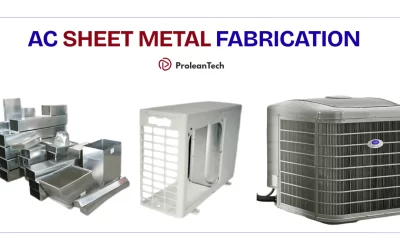
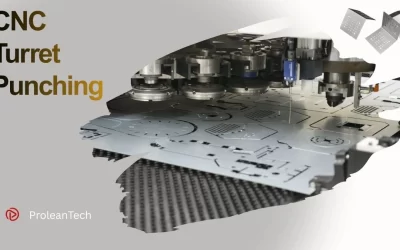
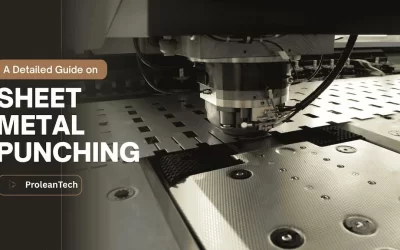
0 Comments